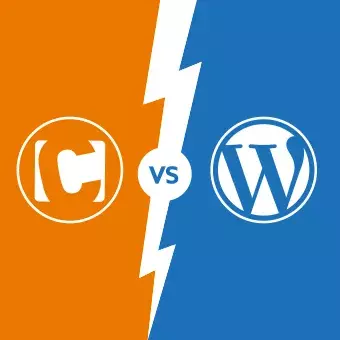Introduction
In the ever-changing world of Content Management Systems (CMS), two names that have both been around now for over 20 years (!) are often heard: Drupal and WordPress.
Both have left their mark on the world of web development, powering countless websites across the globe. In this article, we’ll dissect the strengths of each platform from a developer’s viewpoint.
History and Background
Drupal, created in 2000 by Dries Buytaert, started as a message board but swiftly evolved into an open-source CMS.
WordPress, on the other hand, emerged in 2003 from the efforts of Matt Mullenweg and Mike Little, initially as a user-friendly blogging tool but soon expanded its horizons.
Looking for a Drupal Agency?
Ease of Use
Both platforms champion user-friendliness, but cater to slightly different audiences.
WordPress being inherently user-friendly, allows developers to get a site up and running swiftly. The availability of numerous plugins can help in extending the site’s functionality without having to write extensive code. However, this ease can sometimes be a double-edged sword, as relying heavily on plugins can lead to compatibility issues and potential performance bottlenecks.
Drupal has a steeper learning curve compared to WordPress. Its architecture is based on a system of nodes, blocks, and views, which, while offering a high degree of customisation, demands a deeper understanding of its structure. This complexity means that developers can tailor virtually every aspect of a site, making Drupal a favourite for those building intricate, data-heavy sites.
Flexibility and Customisation
Both Drupal and WordPress are renowned for their flexibility, but they achieve this in different manners, catering to varying needs and preferences of developers and businesses.
From a developer standpoint, while WordPress offers a vast repository of ready-made solutions for rapid deployment, Drupal provides a more hands-on approach, favouring those who prioritise depth of customisation over speed of setup.
WordPress
At its heart, WordPress was designed to be extensible. Its plug-and-play nature is largely attributed to its vast ecosystem of plugins. With over 50,000 plugins available in the official repository alone, businesses can add everything from SEO tools and social media integrations to e-commerce capabilities with a few clicks.
Themes in WordPress also play a pivotal role in customisation. Whether one opts for free, premium, or custom-developed themes, the visual appeal and user experience of a site can be significantly enhanced. Furthermore, the WordPress Block Editor allows for real-time previews of changes, making design alterations a breeze.
However, it’s worth noting that while plugins and themes offer quick solutions, they can sometimes clash or bloat the site if not chosen wisely. It’s a delicate balance between ease and efficiency.
Drupal
Drupal adopts a more modular approach. Think of it as a construction kit, providing developers with the fundamental building blocks to craft bespoke digital experiences. While it might not offer the immediate plug-and-play gratification of WordPress, its granular control over content display and user roles is unparalleled.
Drupal’s theming system, while complex, allows for the creation of highly tailored user experiences. Its flexibility shines in scenarios where intricate data models or multilingual capabilities are required. Modules in Drupal, akin to WordPress plugins, extend the platform’s capabilities. However, they often demand a more in-depth understanding to implement effectively.
Another standout feature is Drupal’s ability to handle ‘content relationships’. For projects requiring intricate data interplay—like online directories or e-commerce sites with multiple product attributes—Drupal’s flexibility is hard to match.
Security
In the digital age, security is paramount. While both platforms offer robust security features, the effectiveness largely depends on the diligence of the administrators and developers maintaining the site. It’s a shared responsibility between the platform and its users.
WordPress
Being the most widely used CMS in the world, WordPress often finds itself in the crosshairs of cyber attacks. It’s important to note, however, that the core of WordPress is very secure. Many vulnerabilities arise from poorly coded or outdated plugins and themes. The WordPress team is proactive, regularly releasing updates and patches to address known security threats.
The vast WordPress community also plays a significant role in its security. With so many eyes on the platform, vulnerabilities are quickly spotted and addressed. Nevertheless, the onus often falls on site administrators to ensure their WordPress version, plugins, and themes are always up to date. Additional security measures, like two-factor authentication, regular backups, and security plugins, can further fortify a WordPress site.
Drupal
Known for its robust security, Drupal has become the CMS of choice for organisations that prioritise this aspect, including government agencies and large corporations. Its API is designed with security in mind, offering a tight, systematic process for writing and reviewing code.
Drupal’s security team is vigilant, frequently releasing updates and advisories. One of Drupal’s standout features is its granular user access control, allowing admins to specify permissions to the minutest detail. This ensures that users only access what they need, reducing potential risks.
However, just like WordPress, Drupal’s security also hinges on its users. Outdated modules, poor configuration, or weak passwords can make even the most secure system vulnerable. Regularly following best practices, like timely updates and strong password policies, is crucial.
Performance and Scalability
Performance isn’t just about speed—it’s about delivering consistent, responsive experiences, even as a site grows and evolves. Let’s delve deeper into how Drupal and WordPress handle these challenges.
WordPress
Out of the box, WordPress offers decent performance. Its architecture is streamlined, ensuring that sites load swiftly for users. As a platform initially designed for blogging, it’s adept at handling text-rich sites with ease.
However, as a site grows—both in terms of content and traffic—performance can become a concern. The very plugins that extend WordPress’s capabilities can also be its Achilles heel. Too many plugins, or even a single poorly-coded one, can slow a site down.
Fortunately, there are numerous caching plugins and Content Delivery Network (CDN) integrations available for WordPress that can significantly boost site speed. Additionally, choosing a reliable and performant hosting provider is crucial.
When it comes to scalability, WordPress can handle large sites and significant traffic spikes, but it often requires a combination of optimised hosting, diligent database management, and regular performance audits.
Drupal
Drupal is frequently praised for its performance and scalability. Designed with complex, high-traffic sites in mind, it boasts advanced caching capabilities straight out of the box. Drupal’s built-in caching layers, like the Dynamic Page Cache and the BigPipe module, ensure content is delivered to users with lightning speed.
Drupal’s architecture is inherently scalable. It’s no surprise that it powers websites for large-scale entities, from government departments to universities to news conglomerates. Its ability to manage vast amounts of content, coupled with its flexible content relationships, makes it a powerhouse for data-rich sites.
For both platforms, performance and scalability aren’t just about the core software but also about the infrastructure it runs on. A dedicated or cloud hosting environment, combined with a well-configured CDN and cache policies, can work wonders for site speed and responsiveness.
Community and Support
A vibrant community is the backbone of any open-source platform and Drupal and WordPress are no exceptions. These communities often play a crucial role in the continuous development, security, and innovation of the platforms.
WordPress
Given its widespread adoption, WordPress boasts one of the largest and most active global communities. This expansive network includes developers, designers, content creators, and everyday users.
There are countless online forums, blogs, and resources dedicated solely to WordPress, making troubleshooting and learning a relatively easy endeavour. This active community ensures that the platform remains updated, secure, and in tune with the evolving needs of its users.
Drupal
While Drupal’s user base might be smaller compared to WordPress, what it lacks in numbers, it more than compensates in passion and technical prowess, and Drupal’s community is renowned for its commitment to innovation and collaboration.
Furthermore, the Drupal community’s commitment to security is commendable. The dedicated security team, backed by community members, ensures that vulnerabilities are swiftly identified and addressed.
Online forums, like Drupal.org, serve as knowledge repositories, assisting users with everything from basic queries to advanced development challenges. The collaborative spirit of the Drupal community ensures that the platform remains at the forefront of technological advancements.
Conclusion
In the Drupal vs WordPress debate, there’s no one-size-fits-all answer. Each platform offers distinct advantages, depending on project requirements, budget, and technical expertise.
Our choice between the two for any particular project depends on a myriad of factors. This includes the specific requirements of a project, the client’s prior experience with each platform, and their vision for the site’s future growth and evolution.





